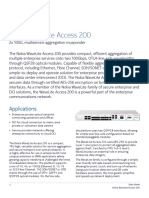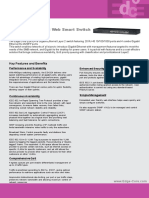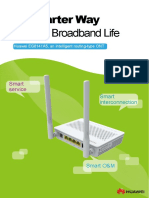Router 6675 Datasheet
Router 6675 Datasheet
Uploaded by
AlexCopyright:
Available Formats
Router 6675 Datasheet
Router 6675 Datasheet
Uploaded by
AlexCopyright
Available Formats
Share this document
Did you find this document useful?
Is this content inappropriate?
Copyright:
Available Formats
Router 6675 Datasheet
Router 6675 Datasheet
Uploaded by
AlexCopyright:
Available Formats
Router 6675
The Router 6675 is a high capacity pre-aggregation and
aggregation router, designed to enable high quality network
Meeting the strictest radio requirements
service delivery while at the same time lowering operating costs Provides high 10GE density with 100GE support and 320Gbps
through features such as a completely filter-less mechanical switching capacity in a 1RU compact and hardened form factor
design. It provides high 10GE and 100GE port densities in a enabling lower rental costs and lower OPEX.
compact and hardened 1RU form factor enabling lower rental
costs and lower OPEX. It supports VPN services over IP/MPLS
networks, service provider SDN, service exposure using
Precise and proven synchronization
NETCONF/YANG, extensive quality of service and precise LTE-A enhancements such as COMP and e-ICIC that enable
synchronization features. efficient use of spectrum have strict synchronization
The Router 6675 has strong security features such as IPSec, requirements. The Ericsson synchronization solution comes pre-
vendor credential and vendor software authentication ensuring verified to work with Radio.
data security even in insecure environments.
With 320Gbps of switching capacity, the Router 6675 delivers
performance needed to fully support LTE, LTE Advanced, 5G, SDN capabilities and programmability
access sites for years to come. Provides application aware traffic engineering with open and
standardized interfaces, enabling network slicing and ability to
The Router 6675 is part of the Ericsson Router 6000 Series, a tailor services for utmost agility.
radio integrated, service provider SDN enabled and subscriber
aware IP transport family of products. The Router 6000 offers a
range of high-performance routers with resiliency features and Designed for low CAPEX and OPEX
form factors optimized for the various needs of metro and
Router 6000 series uses merchant silicon and a cost optimized
backhaul networks.
design to lower CAPEX. Filter less design removes costly truck
rolls every 3 months to inspect the filters, resulting in $1000
The Ericsson Router 6000 Series is an essential component of
yearly OPEX savings/site.
the Ericsson Radio system and is tightly integrated with Ericsson
Radio and Microwave to provide high capacity mobile backhaul
with unprecedented quality of experience. Strong Security
All routers in the Ericsson Router 6000 Series run the IP
Operating System (IPOS), enabling accelerated feature delivery Strong and complete security solution for Macro cell, Small Cell
and operational efficiencies. and Aggregation in trusted and untrusted environments enables
Ericsson Network Manager (ENM) manages the complete end- ubiquitous deployments.
to-end network for both Mobile and Fixed deployments: Radio,
Metro and Backhaul, Mobile Core, and Data Center. This enables Radio integrated Transport
seamless plug and play capabilities for radio and router
installation and network operation. Provides Radio aware transport for mobile backhaul enabling
improved Quality of Experience for end users. Tight hardware
and mechanical integration as part of Ericsson Radio System
allows significantly easier cell site deployment and lower overall
TCO.
Technical specification for Router 6675
Connectivity
Interfaces: 24x GE / 10GE SFP+ ports
4x QSFP28 ports each can be configured as 4x 10GE, 4x 25GE, 1x 40GE or 1x 100GE
1x 100 / 1000 Base-T Ethernet for Out-of-Band Management
1x RJ45 console port
1x RJ45 Alarm port for 3 input and 1 output alarm contacts
1x USB 2.0 port
Synchronization interfaces: 1x RJ45 port 1PPS+TOD (ITU-T G.703 Amd1)
1x RJ48C port for 2.048 MHz, E1/T1 (BITS) input/output
Mechanical
System weight: 8kg / 17.6lbs
Dimension (H x W x D): 1RU 43.6mm x 442.8mm x 315mm
Air flow: Filter-less design, Front to Back with field swappable fan tray
Electrical
Power supply DC: -48 VDC, dual feed
Power consumption: Typical 150 Watts, Max 225 Watts
Environmental
Operating Temperature: -40°C to 65°C
Relative Humidity: 5 - 95% Non-condensing
GR-3108-CORE Class 1: Controlled Protected Environments
GR-3108-CORE Class 2: Protected Equipment in Outside Environments
EN 300 019-1-3 Class 3.3: Not temperature-controlled locations
Key features
IP Routing MPLS: IPv4, IPv6, BGP-4, MP-BGP, BGP FRR, BGP-LS, IS-IS, OSPFv2/v3, VRRPv2/v3, LFA/RLFA/TI-LFA,
RSVP-TE including FRR, LDP, T-LDP, mLDP, Segment Routing, PCEP, Seamless MPLS, CSPF, Routing
policy, Policy based routing , DHCP client/relay/Server
Ethernet: 802.1Q virtual LAN (VLAN), 802.1ad Provider Bridge, IEEE 802.3ad Link Aggregation Control Protocol,
BVI – Bridged Virtual Interface, QinQ, G.8032 Ethernet Ring Protection Switching, BUM storm protection,
Jumbo Frame up to 9600 bytes
Layer-2/Layer-3 Virtual Private Networking: L3 MPLS VPNs, 6VPE/6PE, Inter-autonomous-system MPLS VPN (options A, B, C), VPWS for E-Line
Services, VPLS/H-VPLS for E-LAN Services, Pseudowire redundancy, MEF CE1.0/2.0 Compliant, Ethernet
VPN for E-Line & E-LAN Services
Multicast Protocols: IPv4/IPv6 multicast, PIM-SM/SSM, IGMP v1/v2/v3, MLDv2, MVPN, IGMP snooping*
Timing and Synchronization: IEEE 1588-2008 Precision Time Protocol, ITU-T Profiles for Frequency (G.8265.1 SOOC) and Time/Phase
(G.8275.1 T-BC/GM & G.8275.2 T-BC/GM), NTP, SyncE with ESMC, Enhanced SyncE, Stratum 3E clock, L1
Assist holdover, PTP quality measurement and monitoring
Operation and Maintenance: IEEE 802.1ag Connectivity Fault Management, ITU-T Y.1731 (DM, SLM and Throughput), 802.3ah
Ethernet OAM, Microwave Bandwidth Notification, MACSWAP, MPLS Ping /Traceroute, BFD IPv4 & IPv6
Single Hop, BFD IPv4 & IPv6 Multi Hop, Micro-BFD, Seamless BFD, TWAMP Reflector, TWAMP Initiator,
Port Mirroring, LLDP, IPFIX (IP Flow Information Export)*
Security: Secure boot, Vendor credential, Secured storage, Access control lists, RADIUS, TACACS+, LDAP, SSH
v1/v2, Reverse-path forwarding, IPSec, IKEv2, CMPv2, CRL, TLS, 802.1x port-based network access
control
Quality of Service: Strict-queuing, weighted fair queuing, priority-weighted fair queuing, Multi-tier Hierarchical QoS, Deep
packet buffers, RED/Weighted RED, Ingress policing, Egress shaping, 802.1p, MPLS EXP bits,
Differentiated Services
Network Management: Management by Ericsson Network Manager (ENM), Management by Ericsson OSS-RC, Management by
Ericsson ServiceOn Element Manager (SoEM), CLI, SNMP v2c/v3, NETCONF, YANG models, Syslog,
RMON, PM Job, Zero Touch Provisioning, Telemetry Streaming
Standards and specifications
Safety: LVD Directive 2014/35/EU, IEC/EN 60950-1, IEC/EN 62368-1, CFR 29 Part 1910, UL/CSA 62368-1
EMC: EMC Directive 2014/30/EU, EN 300386, CISPR 32, EN 55032, CISPR 24, EN 55024, EN 50121-1, EN
50121-4, EN 61000-6-1, EN 61000-6-2, EN 61000-6-3, EN 300132-2, EN 300132-1, ES 201468, DTAG 1
TR 9; CFR 47 Part 15, ICES-003; VCCI V-3
ENV: RoHS Directive 2011/65/EU, WEEE Directive 2012/19/EU, EN 300 019-2-1, EN 300 019-2-2, EN 300
019-2-3, EN 300 753, ECE-C1.1
NEBS: GR-1089-CORE, GR-63-CORE, SR-3580 (NEBS Level 3), ATT-TP-76200, VZ.TPR.9203, VZ.TPR.9305
*Future release
1/287 01-FGC 101 3443 Uen Rev M
The content of this document is subject to revision without notice.
© Ericsson AB 2019 Ericsson shall have no liability for any error or damage of any kind
www.ericsson.com resulting from the use of this document.
You might also like
- BoostLi Energy Storage Module ESM-48150B1 User Manual PDFDocument52 pagesBoostLi Energy Storage Module ESM-48150B1 User Manual PDFAlex100% (3)
- Market Guide For Global SIP Trunking Services: Key FindingsDocument15 pagesMarket Guide For Global SIP Trunking Services: Key Findingsishr1980No ratings yet
- Network Segmentation Strategy A Complete Guide - 2021 EditionFrom EverandNetwork Segmentation Strategy A Complete Guide - 2021 EditionNo ratings yet
- Nokia WaveLite Access 200 Data Sheet enDocument3 pagesNokia WaveLite Access 200 Data Sheet enSanti SantiNo ratings yet
- Ericsson Router 6672 DatasheetDocument2 pagesEricsson Router 6672 DatasheetSajid100% (1)
- New Router 6471 Datasheet Rev G PDFDocument2 pagesNew Router 6471 Datasheet Rev G PDFtariq mehmoodNo ratings yet
- 1 28701 FGC 101 3441 Router 6471 Datasheet Rev GDocument2 pages1 28701 FGC 101 3441 Router 6471 Datasheet Rev Gtariq mehmoodNo ratings yet
- 1 28701 FGC 101 3441 Router 6471 Datasheet Rev G PDFDocument2 pages1 28701 FGC 101 3441 Router 6471 Datasheet Rev G PDFtariq mehmoodNo ratings yet
- 1 28701-FGC+101+3441+Router+6471+Datasheet+Rev+FDocument2 pages1 28701-FGC+101+3441+Router+6471+Datasheet+Rev+FВладимир ЕгоровNo ratings yet
- Router 6274: Meeting The Strictest Radio RequirementsDocument2 pagesRouter 6274: Meeting The Strictest Radio RequirementsJamesSmith2014No ratings yet
- Ericsson Router 6673Document2 pagesEricsson Router 6673farzad.aminzade100% (1)
- Router 6000 Ericsson 6273Document2 pagesRouter 6000 Ericsson 6273Zoumana KaridioulaNo ratings yet
- Router 6273: Meeting The Strictest Radio RequirementsDocument2 pagesRouter 6273: Meeting The Strictest Radio RequirementsJamesSmith2014No ratings yet
- Ericsson Router 6676Document2 pagesEricsson Router 6676farzad.aminzadeNo ratings yet
- NPT-1022 Native IP Product NoteDocument2 pagesNPT-1022 Native IP Product NotefquispecNo ratings yet
- (Brochure) Huawei RTN 950Document2 pages(Brochure) Huawei RTN 950Ian RonquilloNo ratings yet
- RTN 905 BrochureDocument2 pagesRTN 905 BrochureHussien EndrisNo ratings yet
- Brochure Huawei RTN 950A enDocument2 pagesBrochure Huawei RTN 950A enrizal100% (1)
- Huawei RTN 905e BrochureDocument2 pagesHuawei RTN 905e BrochureWilliam FernandesNo ratings yet
- WTM3200 Data SheetDocument2 pagesWTM3200 Data SheetparmveerNo ratings yet
- RTN 900 Brochure (910&950) V2.0Document4 pagesRTN 900 Brochure (910&950) V2.0Juan Antonio GranadosNo ratings yet
- RTN910ADocument2 pagesRTN910AJorge Falla LopezNo ratings yet
- RTN 905 2F BrochureDocument2 pagesRTN 905 2F BrochureDiHLoSNo ratings yet
- Ceragon FibeAir IP-20G ANSI DatasheetDocument6 pagesCeragon FibeAir IP-20G ANSI DatasheetarzeszutNo ratings yet
- Optix RTN 980: Provides A Seamless Microwave Transmission Solution For Mobile Communication Network or Private NetworksDocument2 pagesOptix RTN 980: Provides A Seamless Microwave Transmission Solution For Mobile Communication Network or Private NetworksAlfonso Rodrigo Garcés GarcésNo ratings yet
- Siaemic - Ags20.l LeafletDocument4 pagesSiaemic - Ags20.l LeafletErenilson_JesusNo ratings yet
- T5C-XG: Multilayer 10G Ethernet Aggregation SwitchDocument2 pagesT5C-XG: Multilayer 10G Ethernet Aggregation SwitchangelaNo ratings yet
- DS JetNet 5210G V1.1Document5 pagesDS JetNet 5210G V1.1hshirinnezhadNo ratings yet
- RTN950ADocument2 pagesRTN950AClaire100% (1)
- Siaemic - AGS20 - Leaflet - January 2024Document4 pagesSiaemic - AGS20 - Leaflet - January 2024Bilal WarraichNo ratings yet
- Ipasolink Nodal Split Mount Range PDFDocument2 pagesIpasolink Nodal Split Mount Range PDFsyqnamNo ratings yet
- ManualDocument26 pagesManualManoel CoelhoNo ratings yet
- AGS20 Leaflet and DatasheetDocument6 pagesAGS20 Leaflet and DatasheetLázaro VieiraNo ratings yet
- Item 4c.i - Microwave AGS20 Series Datasheet (SIAE)Document6 pagesItem 4c.i - Microwave AGS20 Series Datasheet (SIAE)chee wy100% (1)
- RTN 950 Product BrochureDocument2 pagesRTN 950 Product BrochureAung Aung OoNo ratings yet
- Huawei RTN 980 BrochureDocument2 pagesHuawei RTN 980 BrochureBiznet OTNNo ratings yet
- Data Sheet BIG 2862 en AeDocument4 pagesData Sheet BIG 2862 en AesgueritNo ratings yet
- Siaemic - AGS20 - Leaflet - October 2021Document4 pagesSiaemic - AGS20 - Leaflet - October 2021Miguel MendezNo ratings yet
- Gehad 1400 PTNDocument2 pagesGehad 1400 PTNindrajit ghoshNo ratings yet
- EDS-518E - Series DatasheetDocument2 pagesEDS-518E - Series DatasheetAdlan IzamNo ratings yet
- Aviat CTR 8540 Data SheetDocument2 pagesAviat CTR 8540 Data SheetMuhammed Rayis KalliyilNo ratings yet
- DS Es4324Document2 pagesDS Es4324Sebastian PenzaNo ratings yet
- NPT-1010 Product Note PDFDocument2 pagesNPT-1010 Product Note PDFsantiagobermeoNo ratings yet
- Huawei Optix Osn 1500: Universal Transport Platform For Metro AccessDocument2 pagesHuawei Optix Osn 1500: Universal Transport Platform For Metro AccesskmalNo ratings yet
- Aviat CTR 8540 Data SheetDocument2 pagesAviat CTR 8540 Data Sheetsanosuke_samaNo ratings yet
- Evo™ SmartLink 1.2Document6 pagesEvo™ SmartLink 1.2Ronald TorresNo ratings yet
- DS Siaemic ALS.l - LeafletDocument2 pagesDS Siaemic ALS.l - Leaflete_alvarez_eaamNo ratings yet
- Pasolink Full Packet Radio BrochureDocument2 pagesPasolink Full Packet Radio BrochureGuillermo Fernandez100% (1)
- Industrial Router: UR35 DatasheetDocument6 pagesIndustrial Router: UR35 DatasheetGabriel ZamfirNo ratings yet
- Smartedge 100 Multi-Service Edge RouterDocument4 pagesSmartedge 100 Multi-Service Edge RouterРоман ИващенкоNo ratings yet
- IPasolink 200 400 100 Общее ОписаниеDocument2 pagesIPasolink 200 400 100 Общее ОписаниеSergei MaximovNo ratings yet
- Ags20 Series Universal Aggregation PlatformDocument7 pagesAgs20 Series Universal Aggregation PlatformGonzalo FloresNo ratings yet
- DS 8605 Smart Router 74C0029Document2 pagesDS 8605 Smart Router 74C0029Walisan turiNo ratings yet
- GRX 8000 1Document4 pagesGRX 8000 1573563876luNo ratings yet
- RTN 910+950+980Document6 pagesRTN 910+950+980glukkerNo ratings yet
- CompTIA Network+ (N10-009) Study Guide: Comprehensive Exam Preparation and Key Concepts for Network ProfessionalsFrom EverandCompTIA Network+ (N10-009) Study Guide: Comprehensive Exam Preparation and Key Concepts for Network ProfessionalsNo ratings yet
- GSM, GPRS and EDGE Performance: Evolution Towards 3G/UMTSFrom EverandGSM, GPRS and EDGE Performance: Evolution Towards 3G/UMTSTimo HalonenNo ratings yet
- Tcu Integration MopDocument10 pagesTcu Integration MopAlexNo ratings yet
- Comandos Del Router 6000Document3 pagesComandos Del Router 6000AlexNo ratings yet
- Release HistoryDocument226 pagesRelease HistoryAlexNo ratings yet
- Configuration Script CSG - ATN910C-B.HUIZUCAR - PHEONIX.01Document5 pagesConfiguration Script CSG - ATN910C-B.HUIZUCAR - PHEONIX.01AlexNo ratings yet
- Curso RRU 2219 & RRU 4415Document64 pagesCurso RRU 2219 & RRU 4415Alex100% (2)
- Strong Authentication Enrollment Quick Guide PDFDocument8 pagesStrong Authentication Enrollment Quick Guide PDFOscar Sirias100% (1)
- Pedro David Goméz Melara Ericsson OHS For Suppliers PDFDocument1 pagePedro David Goméz Melara Ericsson OHS For Suppliers PDFAlexNo ratings yet
- Nestor Porfirio Menjivar TorresEricsson OHS For Suppliers PDFDocument1 pageNestor Porfirio Menjivar TorresEricsson OHS For Suppliers PDFAlexNo ratings yet
- Chapter1 Part2Document27 pagesChapter1 Part2deemo1354210No ratings yet
- SK Telecom DASDocument2 pagesSK Telecom DASJ.R. ArmeaNo ratings yet
- Telephony VoIP IP Interview Questions and Answers 919Document7 pagesTelephony VoIP IP Interview Questions and Answers 919Md. Rabiul IslamNo ratings yet
- VoIP Switch Characteristics en 0818Document2 pagesVoIP Switch Characteristics en 0818adroidtivi178No ratings yet
- DASAN Product Catalogue (May2016)Document36 pagesDASAN Product Catalogue (May2016)Bui TheQuanNo ratings yet
- IMS Why Use This New Thing? Give Me A Reason FirstDocument3 pagesIMS Why Use This New Thing? Give Me A Reason FirstAlessandro PazNo ratings yet
- Defense Project GuimassingDocument73 pagesDefense Project GuimassingMbangse MarcelNo ratings yet
- Mobile and Pervasive ComputingDocument40 pagesMobile and Pervasive ComputingSuganthiNo ratings yet
- Structured CablingDocument21 pagesStructured CablinglvsaruNo ratings yet
- UE Capabilities OverviewDocument8 pagesUE Capabilities OverviewSri hartini channelNo ratings yet
- NetProbe-2000 ºê Î Å PDFDocument9 pagesNetProbe-2000 ºê Î Å PDFperiNo ratings yet
- SAILOR 4300 L-Band System: User ManualDocument48 pagesSAILOR 4300 L-Band System: User ManualMohamed ElhossenyNo ratings yet
- EG8141A5 Datasheet 01 PDFDocument2 pagesEG8141A5 Datasheet 01 PDFManuel HijarNo ratings yet
- 2014hw12505-Midsem Progress Report Notchup Aug2016-UpdatedDocument3 pages2014hw12505-Midsem Progress Report Notchup Aug2016-UpdatedKola JagadishNo ratings yet
- CS-306 Computer Networks: Today's Topics Wireless LAN IEEE 802.11 LAN'S Wimax BluetoothDocument10 pagesCS-306 Computer Networks: Today's Topics Wireless LAN IEEE 802.11 LAN'S Wimax BluetoothManoj PaliwalNo ratings yet
- Cisco Chapter 14 AssignmentDocument1 pageCisco Chapter 14 AssignmentdavedahlquistNo ratings yet
- Leading The Mobile Transformation: Samad Nouni Consulting Systems EngineerDocument53 pagesLeading The Mobile Transformation: Samad Nouni Consulting Systems EngineerSandip MaityNo ratings yet
- Archer XR500v (APC)Document5 pagesArcher XR500v (APC)Tony DelgadoNo ratings yet
- Calling Objections & RebbutalsDocument2 pagesCalling Objections & RebbutalsMahesh Kumar Yadav SangenaboinaNo ratings yet
- The Practical Experience of Implementing A GSM BTSDocument6 pagesThe Practical Experience of Implementing A GSM BTSCamilo RestrepoNo ratings yet
- FNAL VoIP CUCM UserDocument4 pagesFNAL VoIP CUCM Userdav dNo ratings yet
- Cisco Spa502G 1-Line Ip Phone With Display, Poe and PC Port: HighlightsDocument7 pagesCisco Spa502G 1-Line Ip Phone With Display, Poe and PC Port: HighlightsAdhemar RodoNo ratings yet
- 3G & 4G Technology: by Arun John No: 7 Paulson J Edamana No:49Document63 pages3G & 4G Technology: by Arun John No: 7 Paulson J Edamana No:49Paulson EdamanaNo ratings yet
- Dinstar UC 120 ManualDocument118 pagesDinstar UC 120 Manualosermi.comNo ratings yet
- Addpac AP1000 DSDocument2 pagesAddpac AP1000 DSEnrique RamosNo ratings yet
- Yeastar S-Series Voip PBX: Performance and PowerDocument2 pagesYeastar S-Series Voip PBX: Performance and PowerAgung SetiawanNo ratings yet
- Cinterion Pls83-W: Lte Cat.4 With 2G/3G Fallback For Global and Regional Iot ConnectivityDocument4 pagesCinterion Pls83-W: Lte Cat.4 With 2G/3G Fallback For Global and Regional Iot ConnectivityscribdrbbNo ratings yet
- Cisco 850 Series Integrated Services Routers Data SheetDocument8 pagesCisco 850 Series Integrated Services Routers Data SheetJoannaNo ratings yet
- Brochure 5G CertificationDocument2 pagesBrochure 5G CertificationSilamparasu BsnlNo ratings yet


































































































